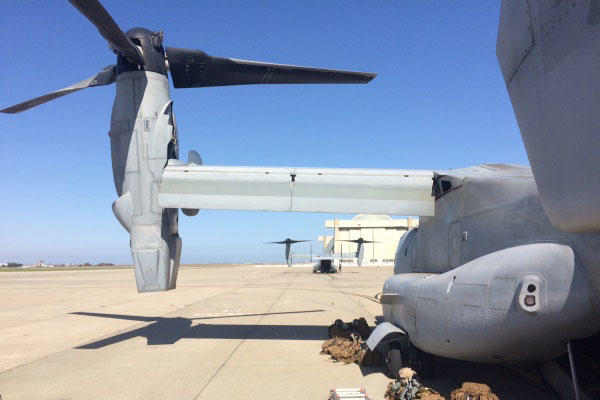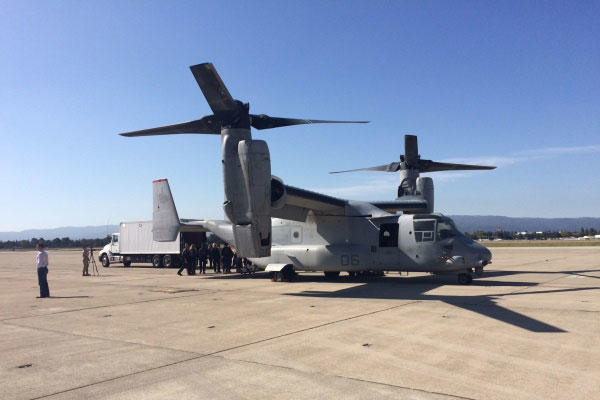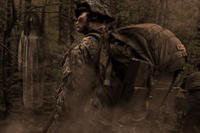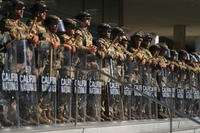MOFFETT FEDERAL AIRFIELD, California -- In a first for the civilian agency, the Federal Emergency Management Agency teamed with the U.S. Marine Corps to practice loading gear onto the MV-22 Osprey to explore the possibility of someday using the military aircraft during domestic emergencies.
The exercise was conducted on Tuesday at Moffett Field, located about 30 miles south of San Francisco, as part of the 35th annual Fleet Week, a weeklong celebration of the Navy, Marine Corps and Coast Guard, held in the city.
Marines flew a pair of Ospreys -- tilt-rotor aircraft that fly like a plane and land like a helicopter -- from Marine Corps Air Station Miramar near San Diego to the airfield -- a distance of almost 500 miles -- in about an hour and a half. The trip highlights the speed and versatility of the $70 million aircraft, officials said.
"Bottom line is, the military has a lot of assets that other parts of the government can only dream of," John Warren, a safety officer with FEMA's California Task Force 3, one of two urban search and rescue teams that participated in the training event, said in an interview with Military.com.
During an emergency such as a flood or an earthquake, the Osprey could quickly insert special FEMA units into the field -- "or a fleet of four aircraft could move a whole team when roads and bridges and normal means of transportation aren't available," he said.
Related Video:
Osprey Evolution
Marine Maj. Stefan Sneden, the defense support of civil authorities officer for the 1st Marine Expeditionary Force, based at Camp Pendleton, said the MV-22 "will absolutely be used in a natural disaster" in the U.S. someday, but the authority for when and how the aircraft respond will come from the federal government, not the military.
"So it's especially important to work with people who are going to say when and how they're needed," he said.
Both the Marine Corps and the Air Force fly the aircraft, which was developed in the 1990s -- indeed, much of the early research and development for tilt-rotors was conducted at the nearby NASA Ames Research Center.
While the aircraft had a rocky start -- accidents resulted in three dozen fatalities, mostly in the 1990s during testing -- crew members said it now has one of the best safety records in the fleet. The Osprey is frequently flown to transport troops, including casualties, and supplies in contingency areas. It has also been deployed to provide humanitarian relief, including in the Philippines in 2013 after Typhoon Haiyan devastated much of the country.
During the training exercise at Moffett Field, FEMA officials and Marines strained to push pallets of gear and equipment, including self-contained breathing apparatuses, air canisters and empty fuel containers, up the inclined ramp of the Osprey.
The MV-22 carries four crew members, including a commander, co-pilot, crew chief and aerial observer, and has seats to accommodate a total of two dozen passengers without cargo, officials said. The plane has a max gross weight of 52,600 pounds, can fly at speeds of as more than 300 miles per hour and has an operational range of about 1,000 nautical miles, they said.
Marine Capt. Elizabeth Trombitas, commander of one of the Ospreys, and her crew recently returned from a deployment to Kuwait, where they flew missions in support of Operation Inherent Resolve, the name of the U.S. military operation against militants affiliated with the Islamic State in Iraq and Syria, or ISIS (also known as ISIL).
"It is a very capable aircraft," she said when asked about its performance supporting combat missions. "But just like other aircraft, you need to put the planning in place to maximize its capability."
When asked what she thought of the idea of using Ospreys someday for stateside medical evacuations, she said, "That would be awesome," then, looking at her aircraft, added, "maybe a less ruggedized version."
In addition to its large frame, the MV-22 includes unique features designed to help with landings in dessert areas, such as particle separators to counteract sand getting sucked into the engines, Trombitas said. That kind of technology might not be needed for domestic flights, she said.
Even so, Marine and FEMA officials were optimistic about eventually using the aircraft for domestic emergencies, though nobody speculated on when that might actually occur.
"I don't think it's a matter of if it will happen, it's about when it will happen," said Rob Robertson, a logistics specialist with FEMA's Task Force 3. "Look at where we're living -- we have major earthquakes, fires -- any type of disaster."
--Brendan McGarry can be reached at brendan.mcgarry@military.com.
Follow him on Twitter at @Brendan_McGarry.





























